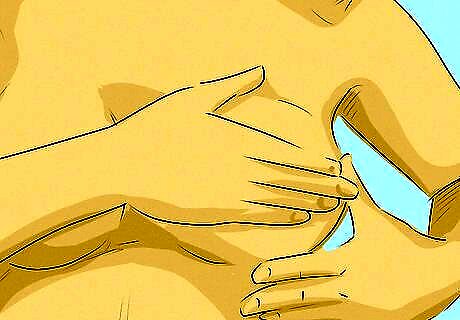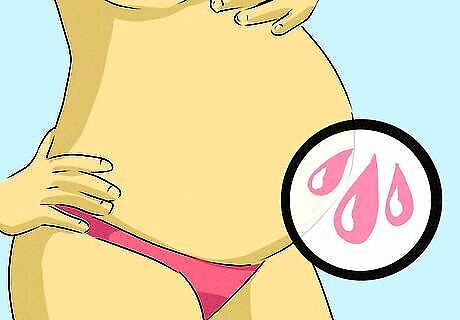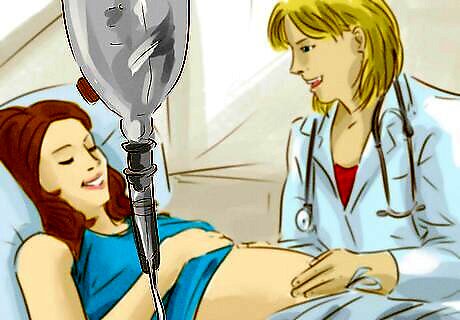
views
X
Research source
It can be incredibly frustrating to suddenly have labor stall. Not to worry, though—there are many things you can do to speed up labor, from shifting your position to creating a soothing atmosphere. If natural methods don't seem to help, talk to your doctor about possible medical interventions.
- Move around to help your baby shift. Go for a walk, walk up and down the stairs, or switch from lying on your back to your side.
- Both nipple stimulation and having an orgasm may help speed up early labor.
- While you wait, try to find ways to relax. Take a bath, read a book, or lie down for a nap if you're able to.
Moving Around to Help the Baby Shift

Get up and walk around. Walking can help the baby shift in the uterus, causing it to the descend towards the pubic bone. This sends a signal to your body that the baby is ready to be born, which may trigger labor to progress. Walking up and down stairs can be especially helpful to shift a baby in the right position for birth.

Shift around when you're lying down. Even if you're too tired to be walking up and down the stairs, you can move around in bed to help the baby reposition. Shift from your back to your side, for example, and then switch it up again a few minutes later. Staying in the same position will not help the baby move to speed up labor. Going from a sitting to standing position can be helpful. Try to get out of bed a few times an hour. If possible, walk around the room a bit before lying back down. Try lying on your left side. This increases blood flow to the baby and may improve pain.

Get on all fours. Your back will feel better, and you'll help the baby rotate into the face-down position he or she needs to take to come out. Get on the floor and gently hold yourself up on your hands and knees. Kneel on a pillow if that's more comfortable. However, it's a good idea to talk to your doctor before you try this or any other unusual stretches or movements. You want to make sure such motions are safe for your specific pregnancy.
Trying Other Methods

Relax and wait. Usually, the best thing you can do during prolonged labor is relax and accept you need to wait. If your doctor thinks your pregnancy is progressing normally, there is not a lot for you to do other than try to remain calm. As you usually do not have to go to the hospital during early labor, do things around your home to wind down like reading a soothing book or watching a movie you enjoy.

Create a soothing environment. While further studies are needed some evidence suggests stress could stall pregnancy. It certainly couldn't hurt to create a soothing, stress-free environment for yourself and it may help you get through early labor faster. Evaluate the room and take note of anything you don't like. Is the television too loud? Are the lights brighter than you'd like? Do you want more privacy? Make any adjustments you need to create a soothing room for yourself. This may result in early labor picking up again.

Take a soothing bath. A nice warm bath can be relaxing, and can also help if you're feeling any physical pain from labor. While you're waiting for labor to progress, draw yourself a nice, warm bath and linger in the water until you feel calm.

Try to sleep. While sleep does not always speed up labor, it can make the time feel like it's going by faster. It's also a good idea to sleep during the early stages of pregnancy when you're able to get rest. Eventually, you will progress to later stages where you'll need to push. Sleeping can help you build up strength. If you went into early labor during the night, it's particularly important to try to get some sleep.

Try nipple stimulation. Nipple stimulation has been known to speed up early labor for some. If you're having trouble getting through early labor, you can roll your nipples between your thumb and pointer finger. You can also rub your nipple with your palm. If you want, you can have a partner or a nurse do this for you. However, some women's nipples are very sensitive throughout pregnancy. If your nipples are sore, do not cause yourself discomfort by engaging in nipple stimulation.

Have an orgasm. There is some evidence that having an orgasm can help labor progress. If you want, you can try to engage in sexual activity with your partner to bring about an orgasm. You can also try masturbation.
Seeking Medical Solutions

Apply acupuncture or acupressure. If you can, book an acupuncture appointment during early labor. Research shows that acupuncture can be beneficial in inducing labor, although doctors aren't entirely sure what its role is. If your partner or midwife knows acupuncture, you can simply have them speed up your labor.

Ask a doctor or midwife to break your water. If your labor has been stalled for a long time, a doctor or midwife may suggest manually breaking your water to help labor progress. This is usually done during active labor, however, but may be done earlier in rare cases. Only go this route if your doctor or midwife suggest it, as you should not attempt to manually break your water on your own.

Try a hormonal drip. A hormonal drip administers Syntocinon, an artificial form of oxytocin which is a hormone that helps with labor. Your doctor will need to monitor your baby's heartbeat if a hormonal drip is used. It may help speed up a labor that has stalled.




















Comments
0 comment